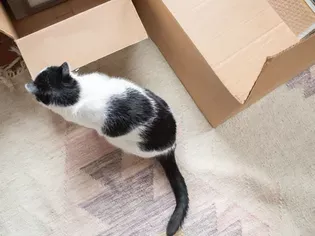How to Move With a Cat
Updated on 04/26/24

The Ultimate Guide to Relocating with Your Feline Companion
Moving can be a stressful experience for both humans and their furry companions. Cats, in particular, are creatures of habit and routine, and even minor changes can disrupt their equilibrium. However, with proper planning and a little understanding of their needs, you can make the transition smooth and comfortable for your feline friend.
Before You Move:
* Establish a Safe Room: Designate a quiet, familiar room in the new home as the "safe room." This will serve as your cat's sanctuary during the move and the initial adjustment period. Ensure it has familiar items like bedding, toys, and a litter box.
* Gradually Introduce the New Home: If possible, allow your cat to visit the new home before the move to familiarize themselves with the surroundings. Monitor their reactions and provide plenty of reassurance.
* Pack Essential Items Separately: Pack your cat's necessities (food, water, litter, medication) in a separate and easily accessible bag. This will ensure their immediate needs are met upon arrival.
During the Move:
* Keep Your Cat Safe and Calm: Transport your cat in a secure carrier covered with a blanket or towel to reduce stress. Avoid exposing them to loud noises or sudden movements.
* Unload the "Safe Room" First: Unload the items for the "safe room" first and set it up immediately. This will provide your cat with a comforting and familiar space as soon as they arrive.
* Monitor Your Cat Closely: Allow your cat to explore the safe room initially and monitor their behavior closely. Look for any signs of distress or anxiety.
After the Move:
* Keep Your Cat Indoors: For the first few weeks after the move, keep your cat indoors to allow them to adjust to their new environment and avoid potential escape attempts.
* Maintain Routine: As much as possible, maintain your cat's usual feeding, playtime, and grooming routines. Predictability and familiarity will help them settle in faster.
* Provide Vertical Spaces: Cats love to perch high up. Offer them vertical space in the form of cat trees, window perches, or shelves to provide them with a sense of security and control.
* Consider a Feliway Diffuser: Feliway pheromone diffusers release a synthetic version of the natural pheromone produced by cats when they feel safe and secure. This can help reduce stress and anxiety during the move and adjustment period.
Addressing Potential Challenges:
* Hiding and Withdrawal: Some cats may hide or withdraw during the move. Provide them with plenty of hiding spots and respect their need for space. Encourage their presence gradually through gentle interactions and treats.
* Litter Box Issues: Moving can disrupt a cat's litter box habits. If they are not using the litter box, check for potential stressors or discomfort, such as an unfamiliar litter type or a dirty box.
* Aggression or Territorial Behavior: Cats may become aggressive or territorial in a new environment. Ensure they have plenty of resources (food, water, litter boxes) and avoid overwhelming them with attention or interactions. If aggression persists, consult with a veterinary behaviorist.
Examples of Successful Moves:
* Leo's Story: Leo, a shy and sensitive cat, was reluctant to move with his family. By gradually introducing him to the new home, establishing a safe room, and maintaining his routine, they helped Leo adapt smoothly.
* Bella's Adventure: Bella, an adventurous and curious cat, was excited about moving. Her family used a Feliway diffuser to reduce stress, and she quickly made the new home her own by exploring vertical spaces and engaging in playtime.
* Milo's Challenge: Milo, a senior cat with arthritic joints, had difficulty adjusting to the move. His family provided him with ramps and stairs to facilitate movement, and they scheduled gentle exercise sessions to help him stay active.
Remember, moving with a cat is a unique experience for each individual. By understanding their needs, planning thoroughly, and providing a supportive and comforting environment, you can help your feline companion thrive in their new home.
Explore More Pets

Cat Behavior Problems
How to Stop Aggression in Kittens

Long-Haired Cat Breeds
Siberian Cat: Breed Profile, Characteristics, & Care

Cat Behavior Problems
How to Stop Kittens From Scratching and Biting

Long-Haired Cat Breeds
Turkish Angora: Cat Breed Profile, Characteristics & Care

Basic Training
How to Socialize Your Kitten

Short-Haired Cat Breeds
Cute Pictures & Facts About Calico Cats & Kittens

Litter Box Training
Training Your Kitten to Use the Litter Box

Long-Haired Cat Breeds
10 Fun Facts About White Cats